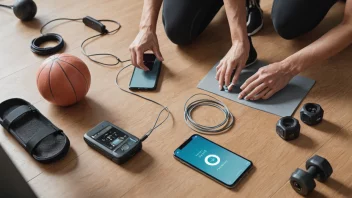In today’s fast-paced world, tracking your training progress is essential for athletes of all levels. With the advent of technology, numerous apps have been developed to help you monitor your workouts, set goals, and analyze your performance. These tools not only enhance your training experience but also promote safety by allowing you to make data-driven decisions. Below, we address some common questions about the best apps available for tracking your training progress.
What are some popular apps for tracking training progress?
There are several popular apps that cater to various types of training. Here are a few:
- Strava: Ideal for runners and cyclists, Strava allows users to log their activities, track performance metrics, and connect with a community of athletes.
- MyFitnessPal: While primarily a nutrition tracker, MyFitnessPal also lets users log workouts and monitor their progress towards fitness goals.
- TrainingPeaks: Great for serious athletes, TrainingPeaks offers detailed performance analysis and personalized training plans.
- Fitbod: Tailored for strength training, Fitbod generates workout plans based on your past performance and available gym equipment.
How do these apps improve training safety?
Many of these apps help improve safety by allowing users to:
- Monitor their exertion levels to avoid overtraining.
- Track their heart rate to ensure they are working within a safe range.
- Set alerts for hydration and nutrition, which are crucial for preventing injuries.
Can I use these apps for multiple sports?
Yes! Most of the popular training apps support multiple sports. For instance, Strava is well-suited for cycling and running, while MyFitnessPal allows you to log various activities and workouts. This versatility makes it easier for athletes who participate in different sports to keep track of their overall performance.
Are there free options available, or do I need to pay?
Many of these apps offer free versions with essential features, while premium subscriptions unlock advanced functionalities. For example, Strava and MyFitnessPal provide basic tracking for free but charge for premium features such as advanced analytics and personalized training plans. It’s worth exploring the free versions first to see if they meet your needs.
How can I ensure I’m using the app effectively?
To get the most out of tracking apps, consider the following tips:
- Set Clear Goals: Clearly define your fitness goals, whether it’s running a certain distance or lifting a specific weight.
- Log Consistently: Regularly log your workouts and activities to track your progress accurately.
- Utilize Analytics: Dive into the analytics provided by the app to understand your performance trends and make necessary adjustments.
- Engage with Community Features: Many apps offer social networking features that allow you to connect with others for motivation and support.
Do these apps integrate with wearables?
Yes, most training apps integrate seamlessly with various wearable devices, such as fitness trackers and smartwatches. This integration allows for automatic syncing of data, providing a more comprehensive view of your training progress. For instance, Strava can sync data from devices like Garmin and Fitbit, enhancing the accuracy of your training logs.
Are the data provided by these apps accurate?
The accuracy of the data largely depends on the device you’re using to track your workouts. Most modern wearables and smartphones have built-in sensors that provide fairly accurate data. However, keep in mind that environmental factors, like GPS signal strength and terrain, can affect the readings. It’s always best to use these apps in conjunction with your own observations and experiences.
Can I use these apps for injury rehabilitation?
Yes! Many apps can help with injury rehabilitation by allowing you to track your recovery progress. You can log specific exercises prescribed by your therapist, monitor your pain levels, and record any modifications you need to make during your recovery. This will help ensure that you are gradually increasing your activity level in a safe manner.
In conclusion, using training apps can significantly enhance your athletic performance while ensuring safety. By tracking your progress, setting achievable goals, and utilizing the insights provided, you can make informed decisions that lead to improved results. Whether you are a beginner or a seasoned athlete, there’s an app out there to help you on your fitness journey.






